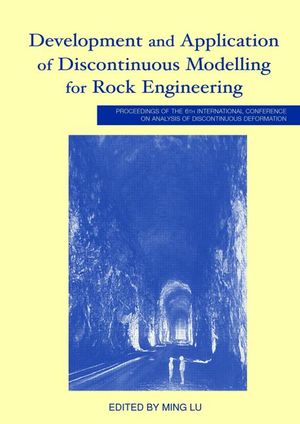ICADD-6 Proceedings
Jump to navigation
Jump to search
Contents
Proceedings of the 6th International Conference on Analysis of Discontinuous Deformation
Development and Application of Discontinuous Modelling for Rock Engineering
Editors
- Ming Lu
Contents
- Rock Global Stability Estimation by Three Dimensional Block Formed with Statistically Produced Joint Polygons. Gen-Hua Shi. pages 3-11.
- A Decade of DDA Validation. Mary M. MacLaughlin and Elizabeth A. Berger. pages 13-31.
- Influence of Heterogeneity on Crack Propagation Mode in Brittle Rock under Static Load. C. A. Tang, W. C. Zhu, T. H. Yang, Z. Z. Liang, H. P. Xie and Z.H. Chen. pages 33-38.
- Parallel, Distributed and Grid Computing in Discontinua Analysis. A. Munjiza, M. Bonaparte, E. Rougier and J. P. Latham. pages 39-42.
- Development of Three Dimensional Discontinuous Deformation Analyses. Jun Liu and Xianjing Kong. pages 45-54.
- Stability Analysis of a Deep Cut Slope using the DDA Method. J. Liu and Z. K. Li. pages 55-59.
- Validation of DDA Block Deformability under Gravity Loading Conditions. Meagan Joyce Duneman, Mary M. MacLaughlin and Richard P. Donovan. pages 61-64.
- Parametric Study of Wedge Stability using Three-dimensional Discontinuous Deformation Analysis. M. R. Yeung, N. Sun and Q. H. Jiang. pages 65-74.
- Stability Study on the Surrounding Rock of the Underground Powerhouse in Shui Buya Project by DDA. Ding Xiuli, Fu Jing, Dong Zhihong and Wu Aiqing. pages 75-78.
- Nonlinear Discontinuous Deformation Analysis of Structures. Chung-Yue Wang, Ren-Zuo Wang, Tong-Yue Wu, Edward C. Ting and Long-Chyuan Kang. pages 79-91.
- Deformation and Kinematics of Vertically Jointed Rock Layers in Underground Openings. M. Tsesarsky and Y. H. Hatzor. pages 93-101.
- Large Span Cavern Stability Analysis - Practical use of DDA. Therese Scheldt and Ming Lu. pages 103-109.
- Preliminary Development of a Fully Grouted Rock Bolt Element for Discontinuous Deformation Analysis. K. K. Clapp and M. M. MacLaughlin. pages 111-117.
- Preliminary Results Unifying Discontinuous Deformation Analysis (DDA) and the Distinct Element Method (DEM). D. M. Doolin. pages 119-125.
- A Comparison of Dam Fracture Studies Between Physical Model Tests and Numerical Analysis. W. Y. Zhu, P. Lin, R. Q. Yang and Q. Yang. pages 129-132.
- Cracking Simulation of the Wuqiangxi Ship Lock by Manifold Method. Guoxin Zhang, Bofang Zhu and Zhengchao Lu. pages 133-139.
- Moldelling Strong Discontinuties by Manifold Method. Shuiling Wang, Xiating Feng and Hong Zheng. pages 141-144.
- A Higher-Order Variational Numerical Manifold Method Formulation and Simplex Integration Strategy. D. Kourepinis, N. Bićanić and C. J. Pearce. pages 145-151.
- Automatic Programming for High-Order Numerical Manifold Method. Su Haidong, Xie Xiaoling and Liang Qingyu. pages 153-157.
- Numerical Modelling of Normal Faults. Z. Huang, I. Grunnaleite and W. Fjeldskaar. pages 161-168.
- A Virtual Discontinua Modelling Workbench for Geosciences. J. P. Latham, A. Munjiza and E. Rougier. pages 169-174.
- Support Design of River Crossing Tunnel using Keyblock Concept and its Validation by Monitoring of the Countermeasure by Digital Photogrammetry at Suzuka Tunnel. T. Nakai, M. Ryu, Y. Ohnishi, S. Nishiyama and T. Tatebe. pages 175-181.
- Discontinuous Analysis Approach to Full Scale Simulation of Structures Subject to Blast Loads. T. Bangash, A. Munjiza and M. Bonaparte. pages 183-188.
- Mud Loss into a Single Fracture During Drilling of Petroleum Wells: Modelling Approach. A. Lavrov and J. Tronvoll. pages 189-198.
- Recent Examples on the Use of the Distinct Element Approach for Static and Dynamic Analysis of a Rock Slope and for Predicting the Performance of Rock Support in a Tunnel. R. K. Bhasin, A. M. Kaynia and F. Løset. pages 199-206.
- Application of Block Theory in Underground Cavern Rock Stability. Zhang Qihua, Wu Aiqing and Ding Xiuli. pages 207-212.
- Adaptive Cracking Analysis for R/C Structures with Object-Oriented Programming. Feng Jiang, Boning Li and Andrew Deeks. pages 213-221.
- The Role of Ground Improvement in Bridging the Gap Between a Discontinuous Reality and a Continuous Model. S. Xu, P. Grasso and M. Bohlouli. pages 223-235.
- Some Problems Related to Numerical Analysis of Jointed Rock Mass. Ming Lu and Therese Scheldt. pages 237-240.
- Fracture Mechanics Model of Tensile Borehole Failure. M. Belayneh and B. S. Aadnøy. pages 241-248.
- Finite Element Formulation for One-Dimensional Fluid-Flow in Cracks. G. Svanø and G. Eiksund. pages 249-258.
